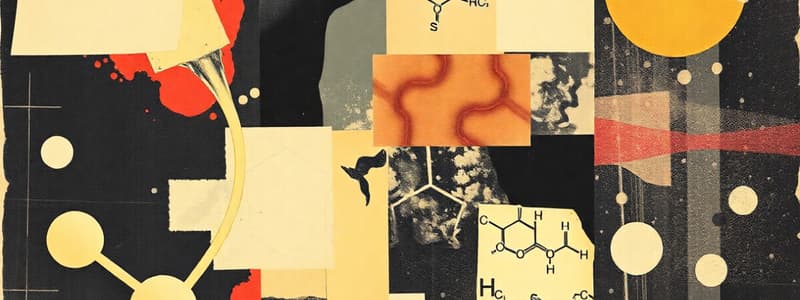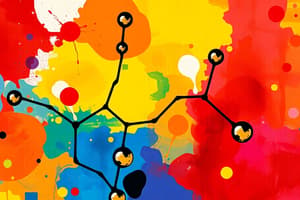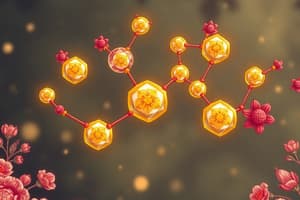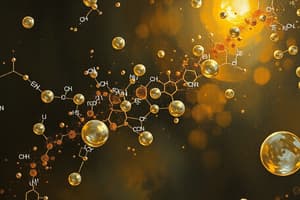Podcast
Questions and Answers
What is the main process by which halogenoalkanes can be formed from alkanes, and what conditions are necessary for this reaction?
What is the main process by which halogenoalkanes can be formed from alkanes, and what conditions are necessary for this reaction?
Halogenoalkanes can be formed from alkanes through free-radical substitution in the presence of UV light.
Describe the steps involved in the free-radical substitution reaction when an alkane reacts with a halogen.
Describe the steps involved in the free-radical substitution reaction when an alkane reacts with a halogen.
The reaction occurs in three steps: initiation, propagation, and termination.
What observation is made during the reaction of an alkene with bromine, and what does it indicate?
What observation is made during the reaction of an alkene with bromine, and what does it indicate?
A red-brown color of bromine vapor is liberated during the reaction, indicating that bromine is being consumed.
Provide an example of an alkene reacting with fluorine and the product formed.
Provide an example of an alkene reacting with fluorine and the product formed.
What is the general reaction mechanism for the electrophilic addition of alkenes with halogens?
What is the general reaction mechanism for the electrophilic addition of alkenes with halogens?
What type of carbocation is formed during the SN1 reaction and why is it considered stable?
What type of carbocation is formed during the SN1 reaction and why is it considered stable?
What is the primary product of the reaction between bromoethane and excess ammonia?
What is the primary product of the reaction between bromoethane and excess ammonia?
Explain the effect of concentration on the rate of SN1 reactions with 2-chloro-2-methylpropane.
Explain the effect of concentration on the rate of SN1 reactions with 2-chloro-2-methylpropane.
Describe the product formation in the reaction of bromoethane with cyanide ion.
Describe the product formation in the reaction of bromoethane with cyanide ion.
In an elimination reaction, what is the role of the hydroxide ion (OH-) from sodium or potassium hydroxide?
In an elimination reaction, what is the role of the hydroxide ion (OH-) from sodium or potassium hydroxide?
In the SN2 mechanism, what determines the rate of the reaction?
In the SN2 mechanism, what determines the rate of the reaction?
Write the overall equation for an elimination reaction of 1-bromo propane using sodium hydroxide in ethanol.
Write the overall equation for an elimination reaction of 1-bromo propane using sodium hydroxide in ethanol.
What is the significance of bromine's electronegativity in bromoethane's reaction with hydroxide?
What is the significance of bromine's electronegativity in bromoethane's reaction with hydroxide?
Why does pent-2-ene become the major product in the elimination reaction of 2-chloro pentane?
Why does pent-2-ene become the major product in the elimination reaction of 2-chloro pentane?
What type of amine is formed when 2-chloro propane reacts with excess ammonia?
What type of amine is formed when 2-chloro propane reacts with excess ammonia?
What type of reaction mechanism does 2-chloropropane undergo when reacting with cyanide?
What type of reaction mechanism does 2-chloropropane undergo when reacting with cyanide?
Describe the initial step involved in an SN2 reaction mechanism with bromoethane and cyanide ion.
Describe the initial step involved in an SN2 reaction mechanism with bromoethane and cyanide ion.
What role does the slow step play in the SN2 reaction mechanism?
What role does the slow step play in the SN2 reaction mechanism?
What are the expected products when treating 2-bromost 2-methyl propane with excess ammonia?
What are the expected products when treating 2-bromost 2-methyl propane with excess ammonia?
In the context of SN2 reactions, how does the structure of the halogenoalkane affect the reaction pathway?
In the context of SN2 reactions, how does the structure of the halogenoalkane affect the reaction pathway?
What distinguishes the electrophilic nature of the carbon atom in haloalkanes during reactions?
What distinguishes the electrophilic nature of the carbon atom in haloalkanes during reactions?
What defines a halogenoalkane and how is it formed?
What defines a halogenoalkane and how is it formed?
What is the general formula for halogenoalkanes?
What is the general formula for halogenoalkanes?
Explain the physical state change of halogenoalkanes with increasing carbon atoms.
Explain the physical state change of halogenoalkanes with increasing carbon atoms.
How does the polarity of the C-X bond affect the physical properties of halogenoalkanes?
How does the polarity of the C-X bond affect the physical properties of halogenoalkanes?
Which halogenoalkane has the highest melting and boiling points and why?
Which halogenoalkane has the highest melting and boiling points and why?
Distinguish between primary and secondary halogenoalkanes.
Distinguish between primary and secondary halogenoalkanes.
What role do the electronegativities of elements play in determining bond polarity in halogenoalkanes?
What role do the electronegativities of elements play in determining bond polarity in halogenoalkanes?
Describe the type of intermolecular forces present in halogenoalkanes.
Describe the type of intermolecular forces present in halogenoalkanes.
What is the product of hydrolyzing a halogenoalkane with water?
What is the product of hydrolyzing a halogenoalkane with water?
Which halogenoalkane undergoes hydrolysis the fastest and why?
Which halogenoalkane undergoes hydrolysis the fastest and why?
How does the rate of hydrolysis differ among tertiary, secondary, and primary halogenoalkanes?
How does the rate of hydrolysis differ among tertiary, secondary, and primary halogenoalkanes?
What role do CFCs play in ozone depletion?
What role do CFCs play in ozone depletion?
What is the main disadvantage of using CFCs as refrigerants?
What is the main disadvantage of using CFCs as refrigerants?
In the context of hydrolysis, why is water a less effective nucleophile than OH-?
In the context of hydrolysis, why is water a less effective nucleophile than OH-?
What is the overall equation for ozone depletion caused by chlorine free radicals?
What is the overall equation for ozone depletion caused by chlorine free radicals?
What alternative can be used instead of CFCs to mitigate environmental issues?
What alternative can be used instead of CFCs to mitigate environmental issues?
What is the primary product formed when propene reacts with hydrogen fluoride according to Markovnikov's rule?
What is the primary product formed when propene reacts with hydrogen fluoride according to Markovnikov's rule?
Explain why aqueous hydrogen halides do not react effectively with alcohol to produce halogenoalkanes.
Explain why aqueous hydrogen halides do not react effectively with alcohol to produce halogenoalkanes.
What are the products formed when an alcohol reacts with phosphorus trichloride (PCl3)?
What are the products formed when an alcohol reacts with phosphorus trichloride (PCl3)?
State the role of sulfur dichloride oxide (SOCl2) in the conversion of alcohol to halogenoalkane.
State the role of sulfur dichloride oxide (SOCl2) in the conversion of alcohol to halogenoalkane.
What should be prepared in-situ to improve the nucleophilicity in the reaction between alcohol and hydrogen halide?
What should be prepared in-situ to improve the nucleophilicity in the reaction between alcohol and hydrogen halide?
What major observation can be made when HCl gas is produced in reactions involving alcohol and phosphorus trichloride?
What major observation can be made when HCl gas is produced in reactions involving alcohol and phosphorus trichloride?
What is the effect of heat in the reaction of alcohol with PCl3 in the presence of phosphorus?
What is the effect of heat in the reaction of alcohol with PCl3 in the presence of phosphorus?
Which hydrogen halide reacts with propene to yield 2-chloro propane as the major product?
Which hydrogen halide reacts with propene to yield 2-chloro propane as the major product?
Flashcards
Halogenoalkane
Halogenoalkane
An organic compound formed by replacing one or more hydrogen atoms in an alkane with a halogen atom.
CnH2n+1X
CnH2n+1X
The general formula for halogenoalkanes, where 'n' represents the number of carbon atoms and 'X' represents a halogen.
Dipole-dipole attraction
Dipole-dipole attraction
The intermolecular force present in halogenoalkanes, caused by the unequal sharing of electrons between the carbon and halogen atoms, creating partial positive and negative charges.
Physical State of Halogenoalkanes
Physical State of Halogenoalkanes
Signup and view all the flashcards
Solubility of Halogenoalkanes
Solubility of Halogenoalkanes
Signup and view all the flashcards
Melting and Boiling Points of Halogenoalkanes
Melting and Boiling Points of Halogenoalkanes
Signup and view all the flashcards
Primary Halogenoalkane
Primary Halogenoalkane
Signup and view all the flashcards
Polarity of C-X Bond
Polarity of C-X Bond
Signup and view all the flashcards
Why are tertiary carbocations more stable?
Why are tertiary carbocations more stable?
Signup and view all the flashcards
Describe the SN1 reaction mechanism.
Describe the SN1 reaction mechanism.
Signup and view all the flashcards
What factors influence the rate of SN1 reaction?
What factors influence the rate of SN1 reaction?
Signup and view all the flashcards
Explain the SN2 reaction mechanism.
Explain the SN2 reaction mechanism.
Signup and view all the flashcards
What affects the rate of SN2 reaction?
What affects the rate of SN2 reaction?
Signup and view all the flashcards
What is a primary (1°) halogenoalkane?
What is a primary (1°) halogenoalkane?
Signup and view all the flashcards
What is a tertiary (3°) halogenoalkane?
What is a tertiary (3°) halogenoalkane?
Signup and view all the flashcards
What happens when a halogenoalkane reacts with KCN?
What happens when a halogenoalkane reacts with KCN?
Signup and view all the flashcards
SN2 Reaction
SN2 Reaction
Signup and view all the flashcards
SN1 Reaction
SN1 Reaction
Signup and view all the flashcards
Nucleophile
Nucleophile
Signup and view all the flashcards
Leaving Group
Leaving Group
Signup and view all the flashcards
Elimination Reaction
Elimination Reaction
Signup and view all the flashcards
Amine
Amine
Signup and view all the flashcards
Reaction of Halogenoalkanes with Ammonia
Reaction of Halogenoalkanes with Ammonia
Signup and view all the flashcards
Zaitsev's Rule
Zaitsev's Rule
Signup and view all the flashcards
Free radical substitution
Free radical substitution
Signup and view all the flashcards
Electrophilic addition of an alkene with a halogen (Halogenation)
Electrophilic addition of an alkene with a halogen (Halogenation)
Signup and view all the flashcards
Chloroalkane
Chloroalkane
Signup and view all the flashcards
Bromoalkane
Bromoalkane
Signup and view all the flashcards
Iodoalkane
Iodoalkane
Signup and view all the flashcards
Hydrolysis of Halogenoalkanes
Hydrolysis of Halogenoalkanes
Signup and view all the flashcards
Effect of Halogen Atom Size
Effect of Halogen Atom Size
Signup and view all the flashcards
Effect of Carbon Chain Structure
Effect of Carbon Chain Structure
Signup and view all the flashcards
Chlorofluorocarbons (CFCs)
Chlorofluorocarbons (CFCs)
Signup and view all the flashcards
CFCs and Ozone Depletion
CFCs and Ozone Depletion
Signup and view all the flashcards
Hydrofluorocarbons (HFCs)
Hydrofluorocarbons (HFCs)
Signup and view all the flashcards
Reduction
Reduction
Signup and view all the flashcards
Oxidation
Oxidation
Signup and view all the flashcards
Markovnikov's Rule
Markovnikov's Rule
Signup and view all the flashcards
Alcohol to Halogenoalkane: Reaction 1
Alcohol to Halogenoalkane: Reaction 1
Signup and view all the flashcards
Alcohol to Halogenoalkane: Reaction 2
Alcohol to Halogenoalkane: Reaction 2
Signup and view all the flashcards
Alcohol to Halogenoalkane: Reaction 3
Alcohol to Halogenoalkane: Reaction 3
Signup and view all the flashcards
Alcohol to Halogenoalkane: Reaction 4
Alcohol to Halogenoalkane: Reaction 4
Signup and view all the flashcards
Testing for -OH Group
Testing for -OH Group
Signup and view all the flashcards
Reaction with Hydrogen Halide
Reaction with Hydrogen Halide
Signup and view all the flashcards
Substitution Reaction
Substitution Reaction
Signup and view all the flashcards
Study Notes
Halogenoalkanes
- Halogenoalkanes are organic compounds where a hydrogen atom in an alkane is replaced by a halogen atom (X).
- General formula for halogenoalkanes is CnH2n+1X (where X = any halogen).
Physical Properties
- The physical state changes from gases to liquids as the number of carbon atoms increases.
- They are slightly soluble in water but soluble in organic solvents.
- Melting and boiling points increase with the increasing number of carbon atoms due to increased strength of dispersion forces.
- Electronegativity difference between carbon and the halogen atom results in permanent dipole-dipole attraction as an intermolecular force.
Classification
- Primary, Secondary, Tertiary halogenoalkanes are based on the number of alkyl groups attached to the carbon atom containing the halogen.
- Primary halogenoalkane: one alkyl group attached to the carbon with the halogen.
- Secondary halogenoalkane: two alkyl groups attached to the carbon with the halogen.
- Tertiary halogenoalkane: three alkyl groups attached to the carbon with the halogen.
Chemical Properties
- Substitution Reaction: Halogenoalkanes undergo nucleophilic substitution (SN1 or SN2) reactions when reacting with nucleophiles like OH⁻, CN⁻, and NH₃.
- SN1 mechanism: favoured by tertiary halogenoalkanes
- SN2 mechanism: favoured by primary halogenoalkanes
- Hydrolysis: Halogenoalkanes react with water (hydrolysis) to form alcohols.
- Primary and secondary halogenoalkanes react with water via SN2 reactions.
- Tertiary halogenoalkanes react with water via SN1 reactions.
- Elimination Reaction: Halogenoalkanes react with ethanolic KOH or ethanolic NaOH to produce alkenes.
- Reaction with KCN (in ethanol): This reaction increases the chain length of the compound by one carbon atom.
- SN1 Reaction Mechanism (with CN⁻): The reaction with CN⁻ involves a carbocation intermediate.
- SN2 Reaction Mechanism (with OH⁻): The reaction with OH⁻ involves a single step where the hydroxyl group attacks the carbon directly.
- Reaction with NH₃ (in ethanol): This reaction yields amines, depending on the excess of ammonia.
- Free Radical Substitution: This reaction involves alkanes and halogens in the presence of ultraviolet light. Reaction occurs in initiation, propagation and termination steps.
- Electrophilic Addition of Alkene with Halogen: Alkenes react with halogens (Cl₂, Br₂, I₂) to form halogenoalkanes.
- Electrophilic Addition of Alkene with Hydrogen Halide: Alkenes react with hydrogen halide (HCl, HBr, HI) to form halogenoalkanes, following Markovnikov's rule (the halogen adds to the carbon with more hydrogen atoms).
Uses
- Halogenoalkanes are used as anaesthetics, refrigerants, and in the production of polymers (e.g., PTFE).
Problems with CFCs
- CFCs deplete the ozone layer, which allows harmful UV rays from the sun to reach the Earth's surface, increasing skin cancer risks.
- CFCs contain carbon-chlorine bonds that are broken down by UV radiation, creating chlorine radicals that catalyze the breakdown of ozone.
- HFCs are alternatives to CFCs to prevent ozone layer depletion.
Studying That Suits You
Use AI to generate personalized quizzes and flashcards to suit your learning preferences.




